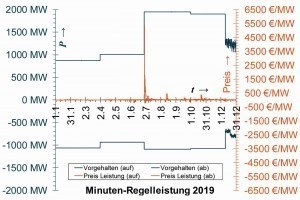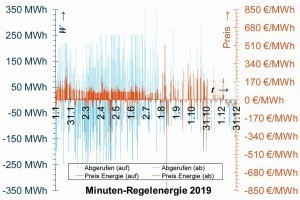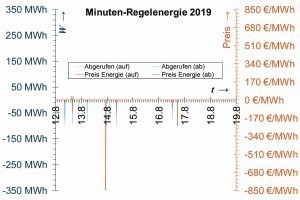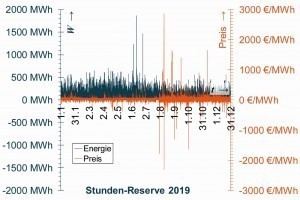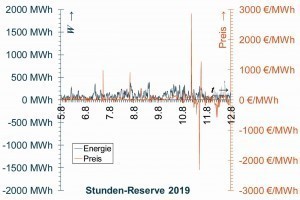Electrical energy is the only product that always has to be generated literally at the same moment it is consumed. Nevertheless, it is practically always available in full - whether it is used or not. How does that work? And can electroplating systems perhaps help to keep it that way?
2.4 Minute reserve - tertiary regulation
The task of the minute reserve or tertiary control "mFRR (manual frequency restoration reserve)" is actually the same as that of the secondary control. However, as the name suggests, it is controlled manually and is correspondingly slower. It is used for economic optimization by switching from the fastest to the most cost-effective option. "Minute reserve is used to replace secondary control energy, is provided with a lead time of down to 7.5 minutes and is called up at a constant level for at least 15 minutes." [1]
The market confirms that this works technically. What the market does not seem to confirm is the cost-effective provision: Just like the secondary balancing power, the amount of minute power provided remains unchanged for long periods throughout most of 2019 and only suddenly starts to fluctuate on December 10 (Fig. 16). Its price, on the other hand, shows a solitary annual peak of EUR 5375.26/MW on June 29 at 11:00 a.m. (Fig. 18) - almost 220 times the average value! The energy price (Fig. 17) shows a similar extreme negative value of - 848.97 Euro/(MWh) on August 13 between 22:30 and 23:00 compared to an annual average of - 2.63 Euro/(MWh) ( Fig. 19). The fact that both energy prices, the average and the extreme value, are negative may be due to the fact that the usual exchange price or a corresponding remuneration is paid for the energy supplied in addition to the balancing energy price. It is difficult to find out whether this is the case, but there is an indication from Switzerland that balancing energy providers there receive "the normal electricity price plus 20 percent" for the energy supplied in addition to the remuneration for the power provided (and if negative balancing energy is required, consumers offering balancing energy receive their electricity 20 percent cheaper if they connect grid-led loads) [2].
According to the information available from the Federal Network Agency for Germany, it is conceivable that the balancing energy providers feed energy into the grid for large parts of the year, although they lose a small amount of their revenue on the exchange due to the slightly negative balancing energy price. This may be more economical than feeding nothing into the grid and receiving no money at all. This could explain why the annual average of the prices paid for balancing energy is not zero, but just below it.
2.5 Hourly reserve
Now that a deviation in frequency has not only been stopped, but the frequency has been brought back to the target value, the energy balances with neighboring control zones must be balanced again, because as mentioned at the beginning, the energy balances of the individual control zones should always be equal to zero in the long term. To this end, each control area must keep its hourly reserve "RR (replacement reserve)" available:
- If there is a supply failure in an entire city, for example, the excess power generated will initially have flowed largely into the neighboring zones. The affected zone must now generate slightly less electrical power than it consumes for an hour or less until the energy balance is restored.
Literature
[1] https://www.bundesnetzagentur.de/DE/Sachgebiete/ElektrizitaetundGas/Unternehmen_Institutionen/Versorgungssicherheit/Engpassmanagement/Regelenergie/regelenergie-node.html
[2] Benedikt Vogel: Network controls electricity every second, ET HK extra, 2015


